HR Report: Developing Individuals, Teams, & Organisations at Whirlpool
VerifiedAdded on 2020/10/22
|17
|5250
|247
Report
AI Summary
This report delves into the essential aspects of human resources within the context of Whirlpool, a multinational appliance manufacturer. The report begins by outlining the professional knowledge, skills, and behaviors expected of HR professionals, including leadership, resource management, and performance management. It then presents a personal skills audit, identifying strengths and weaknesses in relation to a trainee role and proposing a development plan. The report further examines the differences between organizational and individual learning, training and development, and the need for continuous learning to drive sustainable business performance. Finally, it explores how high-performance work contributes to employee engagement and competitive advantage, concluding with an overview of different approaches to performance management within the organization. The report emphasizes the importance of continuous professional development and its impact on organizational success.
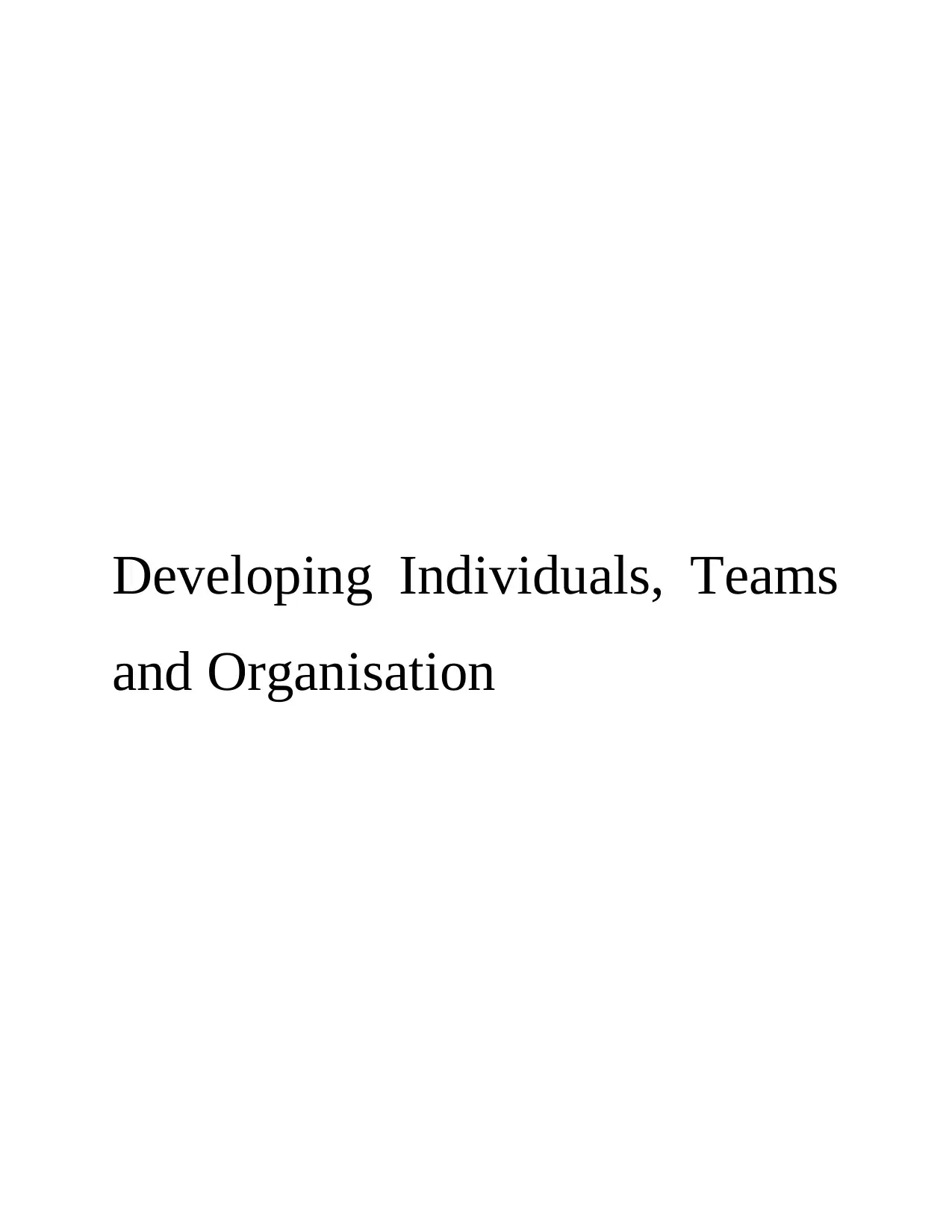
Developing Individuals, Teams
and Organisation
and Organisation
Paraphrase This Document
Need a fresh take? Get an instant paraphrase of this document with our AI Paraphraser
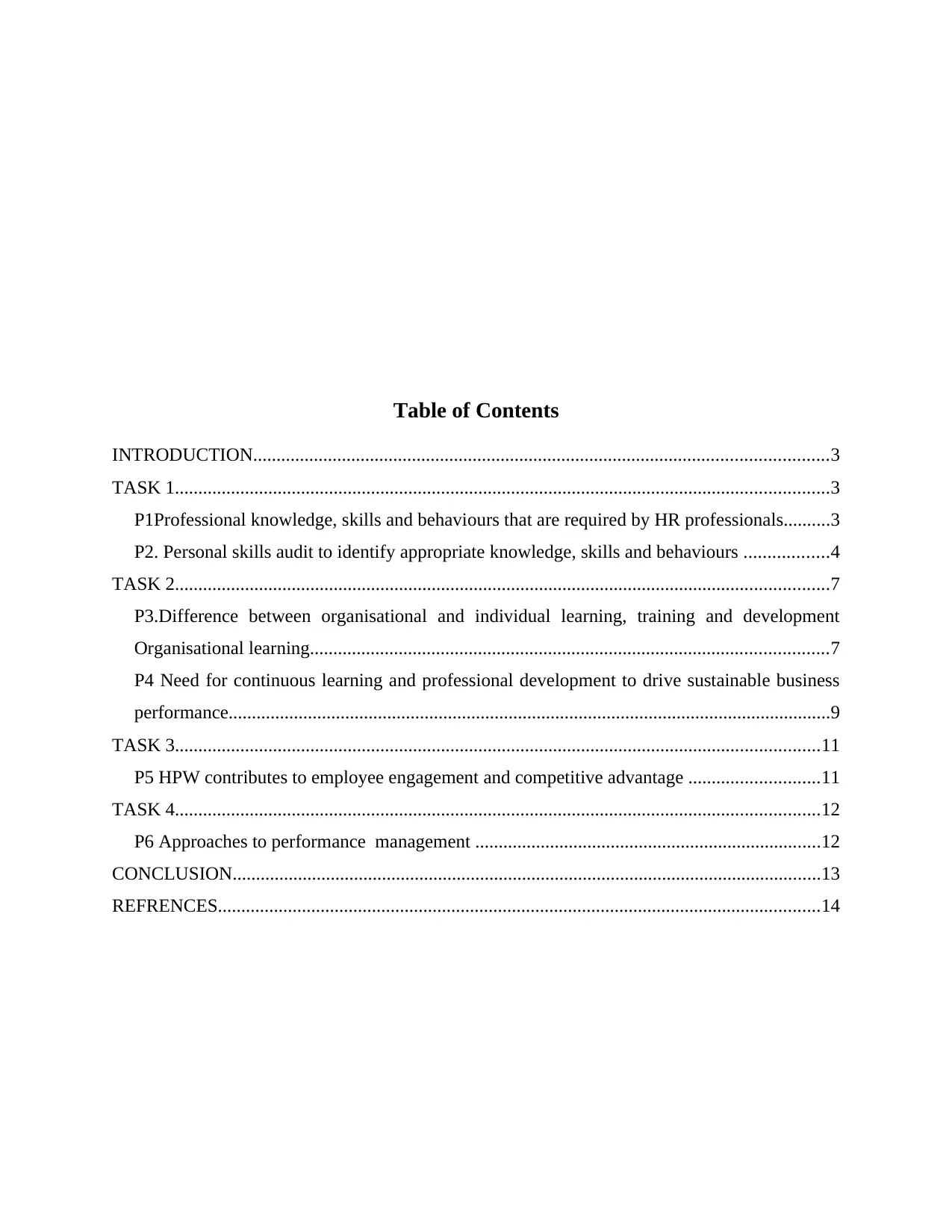
Table of Contents
INTRODUCTION...........................................................................................................................3
TASK 1............................................................................................................................................3
P1Professional knowledge, skills and behaviours that are required by HR professionals..........3
P2. Personal skills audit to identify appropriate knowledge, skills and behaviours ..................4
TASK 2............................................................................................................................................7
P3.Difference between organisational and individual learning, training and development
Organisational learning...............................................................................................................7
P4 Need for continuous learning and professional development to drive sustainable business
performance.................................................................................................................................9
TASK 3..........................................................................................................................................11
P5 HPW contributes to employee engagement and competitive advantage ............................11
TASK 4..........................................................................................................................................12
P6 Approaches to performance management ..........................................................................12
CONCLUSION..............................................................................................................................13
REFRENCES.................................................................................................................................14
INTRODUCTION...........................................................................................................................3
TASK 1............................................................................................................................................3
P1Professional knowledge, skills and behaviours that are required by HR professionals..........3
P2. Personal skills audit to identify appropriate knowledge, skills and behaviours ..................4
TASK 2............................................................................................................................................7
P3.Difference between organisational and individual learning, training and development
Organisational learning...............................................................................................................7
P4 Need for continuous learning and professional development to drive sustainable business
performance.................................................................................................................................9
TASK 3..........................................................................................................................................11
P5 HPW contributes to employee engagement and competitive advantage ............................11
TASK 4..........................................................................................................................................12
P6 Approaches to performance management ..........................................................................12
CONCLUSION..............................................................................................................................13
REFRENCES.................................................................................................................................14
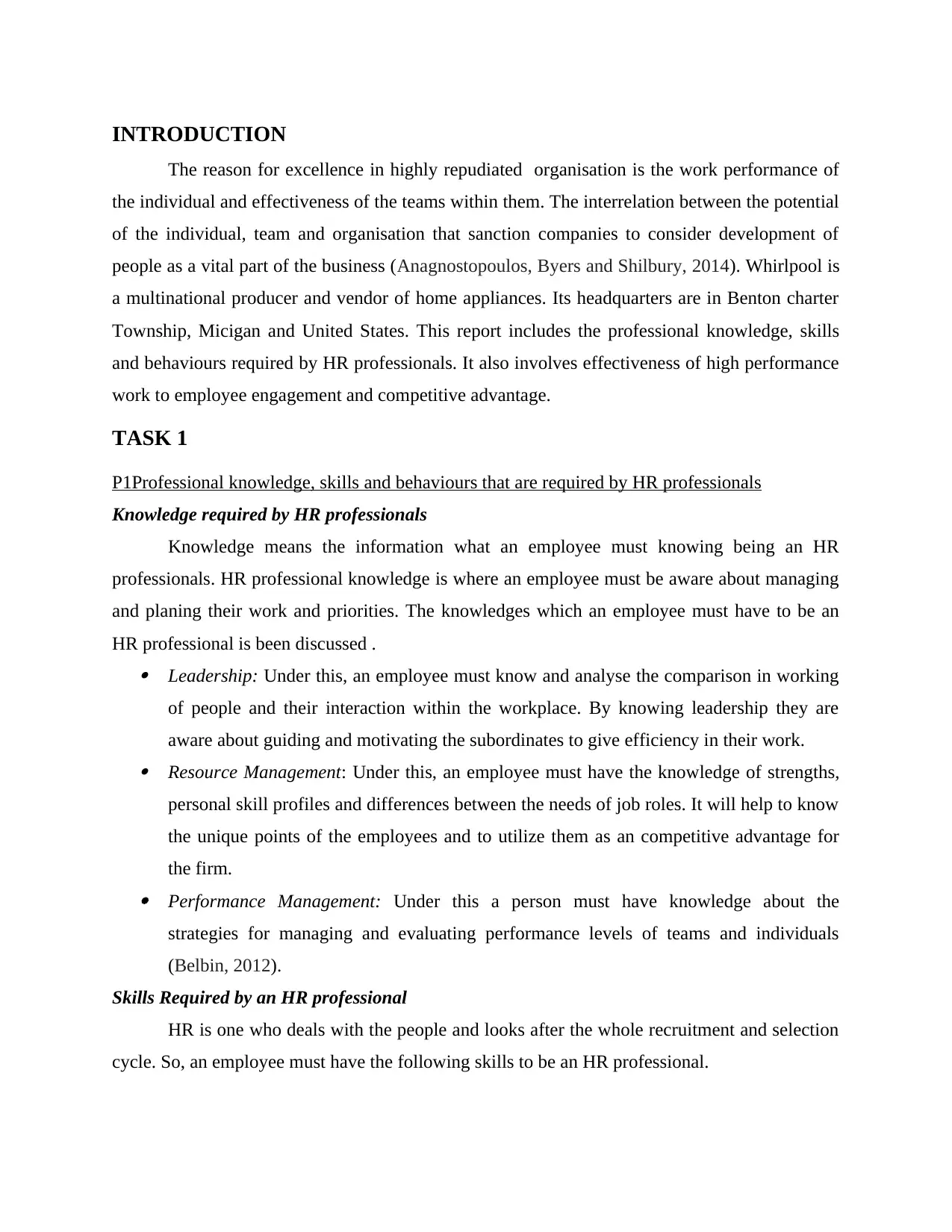
INTRODUCTION
The reason for excellence in highly repudiated organisation is the work performance of
the individual and effectiveness of the teams within them. The interrelation between the potential
of the individual, team and organisation that sanction companies to consider development of
people as a vital part of the business (Anagnostopoulos, Byers and Shilbury, 2014). Whirlpool is
a multinational producer and vendor of home appliances. Its headquarters are in Benton charter
Township, Micigan and United States. This report includes the professional knowledge, skills
and behaviours required by HR professionals. It also involves effectiveness of high performance
work to employee engagement and competitive advantage.
TASK 1
P1Professional knowledge, skills and behaviours that are required by HR professionals
Knowledge required by HR professionals
Knowledge means the information what an employee must knowing being an HR
professionals. HR professional knowledge is where an employee must be aware about managing
and planing their work and priorities. The knowledges which an employee must have to be an
HR professional is been discussed . Leadership: Under this, an employee must know and analyse the comparison in working
of people and their interaction within the workplace. By knowing leadership they are
aware about guiding and motivating the subordinates to give efficiency in their work. Resource Management: Under this, an employee must have the knowledge of strengths,
personal skill profiles and differences between the needs of job roles. It will help to know
the unique points of the employees and to utilize them as an competitive advantage for
the firm. Performance Management: Under this a person must have knowledge about the
strategies for managing and evaluating performance levels of teams and individuals
(Belbin, 2012).
Skills Required by an HR professional
HR is one who deals with the people and looks after the whole recruitment and selection
cycle. So, an employee must have the following skills to be an HR professional.
The reason for excellence in highly repudiated organisation is the work performance of
the individual and effectiveness of the teams within them. The interrelation between the potential
of the individual, team and organisation that sanction companies to consider development of
people as a vital part of the business (Anagnostopoulos, Byers and Shilbury, 2014). Whirlpool is
a multinational producer and vendor of home appliances. Its headquarters are in Benton charter
Township, Micigan and United States. This report includes the professional knowledge, skills
and behaviours required by HR professionals. It also involves effectiveness of high performance
work to employee engagement and competitive advantage.
TASK 1
P1Professional knowledge, skills and behaviours that are required by HR professionals
Knowledge required by HR professionals
Knowledge means the information what an employee must knowing being an HR
professionals. HR professional knowledge is where an employee must be aware about managing
and planing their work and priorities. The knowledges which an employee must have to be an
HR professional is been discussed . Leadership: Under this, an employee must know and analyse the comparison in working
of people and their interaction within the workplace. By knowing leadership they are
aware about guiding and motivating the subordinates to give efficiency in their work. Resource Management: Under this, an employee must have the knowledge of strengths,
personal skill profiles and differences between the needs of job roles. It will help to know
the unique points of the employees and to utilize them as an competitive advantage for
the firm. Performance Management: Under this a person must have knowledge about the
strategies for managing and evaluating performance levels of teams and individuals
(Belbin, 2012).
Skills Required by an HR professional
HR is one who deals with the people and looks after the whole recruitment and selection
cycle. So, an employee must have the following skills to be an HR professional.
⊘ This is a preview!⊘
Do you want full access?
Subscribe today to unlock all pages.

Trusted by 1+ million students worldwide
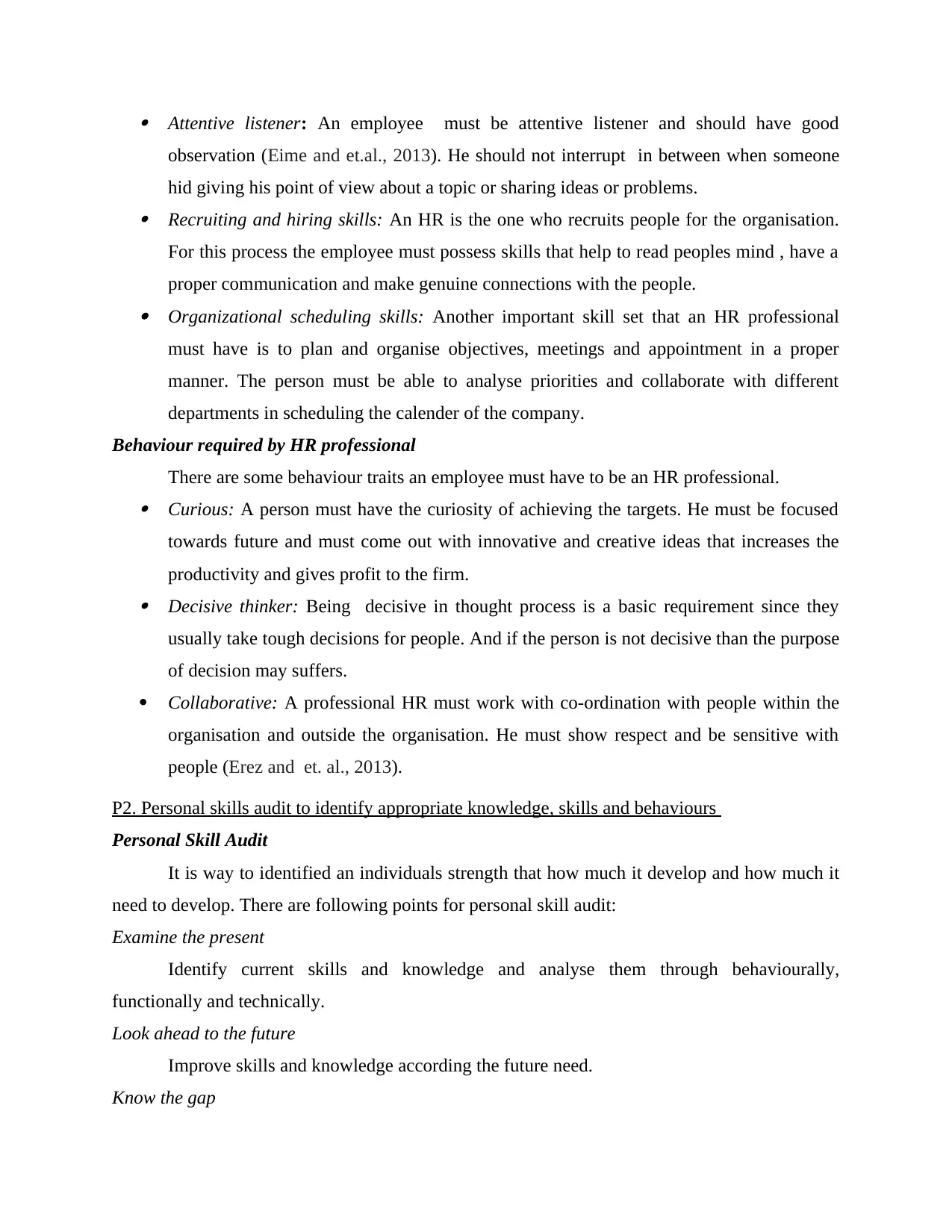
Attentive listener: An employee must be attentive listener and should have good
observation (Eime and et.al., 2013). He should not interrupt in between when someone
hid giving his point of view about a topic or sharing ideas or problems. Recruiting and hiring skills: An HR is the one who recruits people for the organisation.
For this process the employee must possess skills that help to read peoples mind , have a
proper communication and make genuine connections with the people. Organizational scheduling skills: Another important skill set that an HR professional
must have is to plan and organise objectives, meetings and appointment in a proper
manner. The person must be able to analyse priorities and collaborate with different
departments in scheduling the calender of the company.
Behaviour required by HR professional
There are some behaviour traits an employee must have to be an HR professional. Curious: A person must have the curiosity of achieving the targets. He must be focused
towards future and must come out with innovative and creative ideas that increases the
productivity and gives profit to the firm. Decisive thinker: Being decisive in thought process is a basic requirement since they
usually take tough decisions for people. And if the person is not decisive than the purpose
of decision may suffers.
Collaborative: A professional HR must work with co-ordination with people within the
organisation and outside the organisation. He must show respect and be sensitive with
people (Erez and et. al., 2013).
P2. Personal skills audit to identify appropriate knowledge, skills and behaviours
Personal Skill Audit
It is way to identified an individuals strength that how much it develop and how much it
need to develop. There are following points for personal skill audit:
Examine the present
Identify current skills and knowledge and analyse them through behaviourally,
functionally and technically.
Look ahead to the future
Improve skills and knowledge according the future need.
Know the gap
observation (Eime and et.al., 2013). He should not interrupt in between when someone
hid giving his point of view about a topic or sharing ideas or problems. Recruiting and hiring skills: An HR is the one who recruits people for the organisation.
For this process the employee must possess skills that help to read peoples mind , have a
proper communication and make genuine connections with the people. Organizational scheduling skills: Another important skill set that an HR professional
must have is to plan and organise objectives, meetings and appointment in a proper
manner. The person must be able to analyse priorities and collaborate with different
departments in scheduling the calender of the company.
Behaviour required by HR professional
There are some behaviour traits an employee must have to be an HR professional. Curious: A person must have the curiosity of achieving the targets. He must be focused
towards future and must come out with innovative and creative ideas that increases the
productivity and gives profit to the firm. Decisive thinker: Being decisive in thought process is a basic requirement since they
usually take tough decisions for people. And if the person is not decisive than the purpose
of decision may suffers.
Collaborative: A professional HR must work with co-ordination with people within the
organisation and outside the organisation. He must show respect and be sensitive with
people (Erez and et. al., 2013).
P2. Personal skills audit to identify appropriate knowledge, skills and behaviours
Personal Skill Audit
It is way to identified an individuals strength that how much it develop and how much it
need to develop. There are following points for personal skill audit:
Examine the present
Identify current skills and knowledge and analyse them through behaviourally,
functionally and technically.
Look ahead to the future
Improve skills and knowledge according the future need.
Know the gap
Paraphrase This Document
Need a fresh take? Get an instant paraphrase of this document with our AI Paraphraser
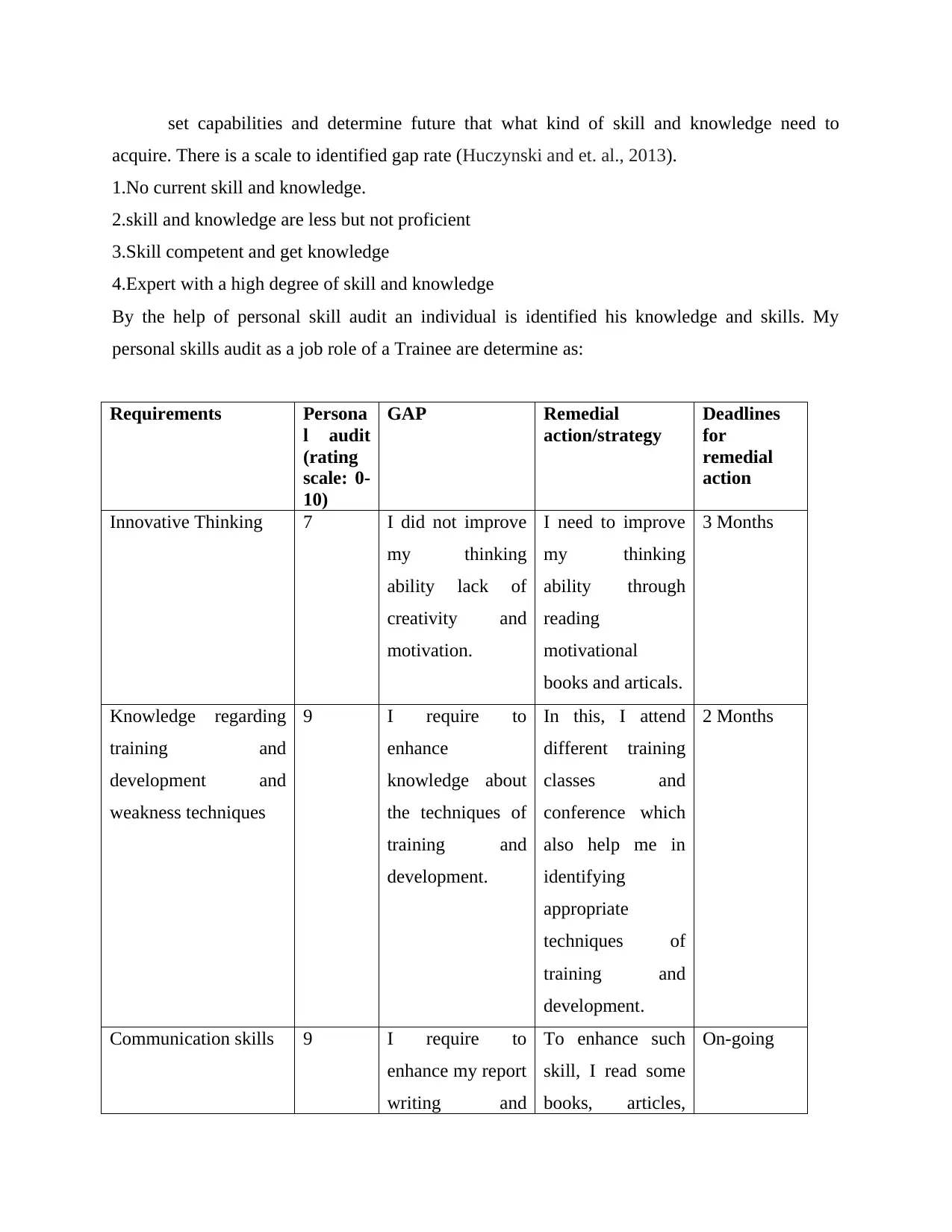
set capabilities and determine future that what kind of skill and knowledge need to
acquire. There is a scale to identified gap rate (Huczynski and et. al., 2013).
1.No current skill and knowledge.
2.skill and knowledge are less but not proficient
3.Skill competent and get knowledge
4.Expert with a high degree of skill and knowledge
By the help of personal skill audit an individual is identified his knowledge and skills. My
personal skills audit as a job role of a Trainee are determine as:
Requirements Persona
l audit
(rating
scale: 0-
10)
GAP Remedial
action/strategy
Deadlines
for
remedial
action
Innovative Thinking 7 I did not improve
my thinking
ability lack of
creativity and
motivation.
I need to improve
my thinking
ability through
reading
motivational
books and articals.
3 Months
Knowledge regarding
training and
development and
weakness techniques
9 I require to
enhance
knowledge about
the techniques of
training and
development.
In this, I attend
different training
classes and
conference which
also help me in
identifying
appropriate
techniques of
training and
development.
2 Months
Communication skills 9 I require to
enhance my report
writing and
To enhance such
skill, I read some
books, articles,
On-going
acquire. There is a scale to identified gap rate (Huczynski and et. al., 2013).
1.No current skill and knowledge.
2.skill and knowledge are less but not proficient
3.Skill competent and get knowledge
4.Expert with a high degree of skill and knowledge
By the help of personal skill audit an individual is identified his knowledge and skills. My
personal skills audit as a job role of a Trainee are determine as:
Requirements Persona
l audit
(rating
scale: 0-
10)
GAP Remedial
action/strategy
Deadlines
for
remedial
action
Innovative Thinking 7 I did not improve
my thinking
ability lack of
creativity and
motivation.
I need to improve
my thinking
ability through
reading
motivational
books and articals.
3 Months
Knowledge regarding
training and
development and
weakness techniques
9 I require to
enhance
knowledge about
the techniques of
training and
development.
In this, I attend
different training
classes and
conference which
also help me in
identifying
appropriate
techniques of
training and
development.
2 Months
Communication skills 9 I require to
enhance my report
writing and
To enhance such
skill, I read some
books, articles,
On-going
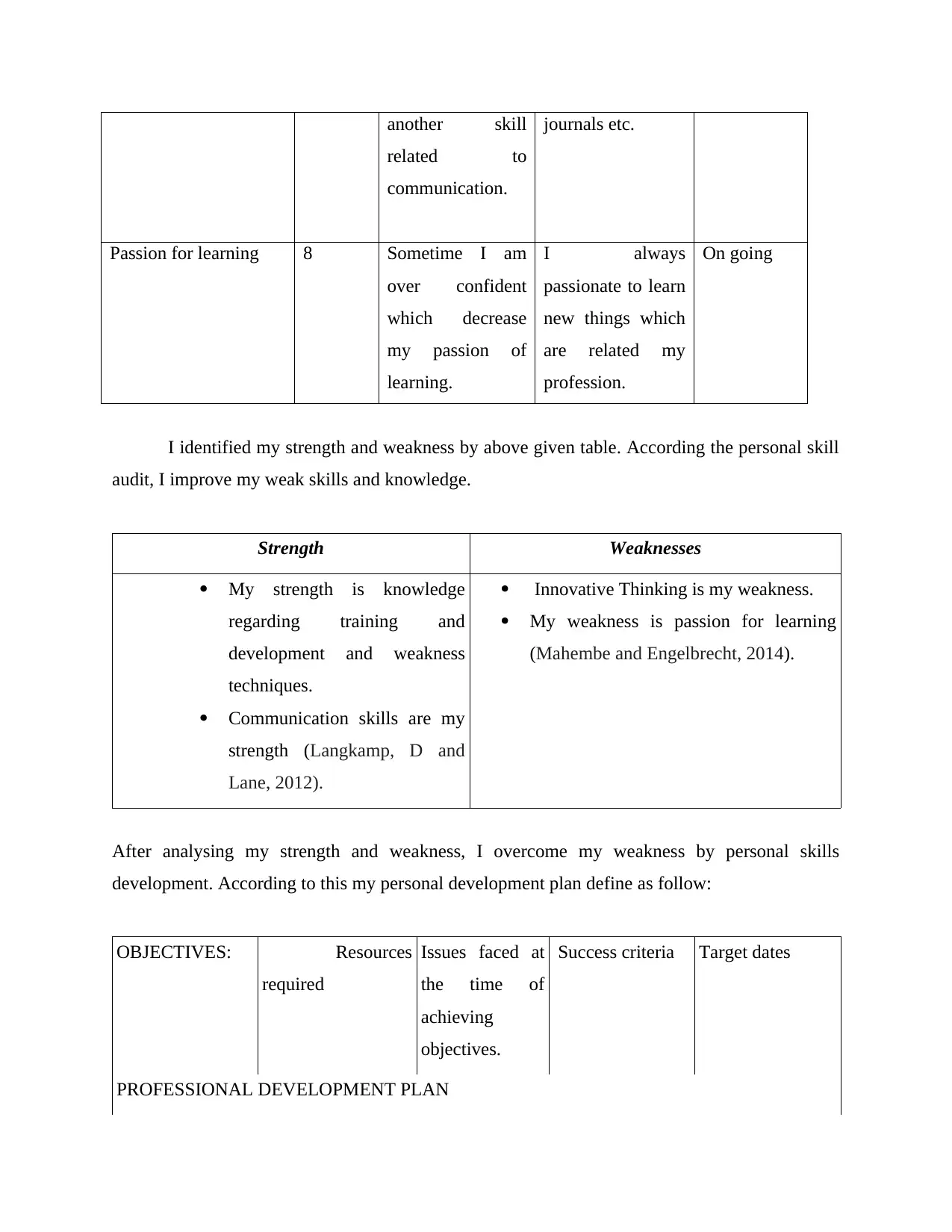
another skill
related to
communication.
journals etc.
Passion for learning 8 Sometime I am
over confident
which decrease
my passion of
learning.
I always
passionate to learn
new things which
are related my
profession.
On going
I identified my strength and weakness by above given table. According the personal skill
audit, I improve my weak skills and knowledge.
Strength Weaknesses
My strength is knowledge
regarding training and
development and weakness
techniques.
Communication skills are my
strength (Langkamp, D and
Lane, 2012).
Innovative Thinking is my weakness.
My weakness is passion for learning
(Mahembe and Engelbrecht, 2014).
After analysing my strength and weakness, I overcome my weakness by personal skills
development. According to this my personal development plan define as follow:
OBJECTIVES: Resources
required
Issues faced at
the time of
achieving
objectives.
Success criteria Target dates
PROFESSIONAL DEVELOPMENT PLAN
related to
communication.
journals etc.
Passion for learning 8 Sometime I am
over confident
which decrease
my passion of
learning.
I always
passionate to learn
new things which
are related my
profession.
On going
I identified my strength and weakness by above given table. According the personal skill
audit, I improve my weak skills and knowledge.
Strength Weaknesses
My strength is knowledge
regarding training and
development and weakness
techniques.
Communication skills are my
strength (Langkamp, D and
Lane, 2012).
Innovative Thinking is my weakness.
My weakness is passion for learning
(Mahembe and Engelbrecht, 2014).
After analysing my strength and weakness, I overcome my weakness by personal skills
development. According to this my personal development plan define as follow:
OBJECTIVES: Resources
required
Issues faced at
the time of
achieving
objectives.
Success criteria Target dates
PROFESSIONAL DEVELOPMENT PLAN
⊘ This is a preview!⊘
Do you want full access?
Subscribe today to unlock all pages.

Trusted by 1+ million students worldwide
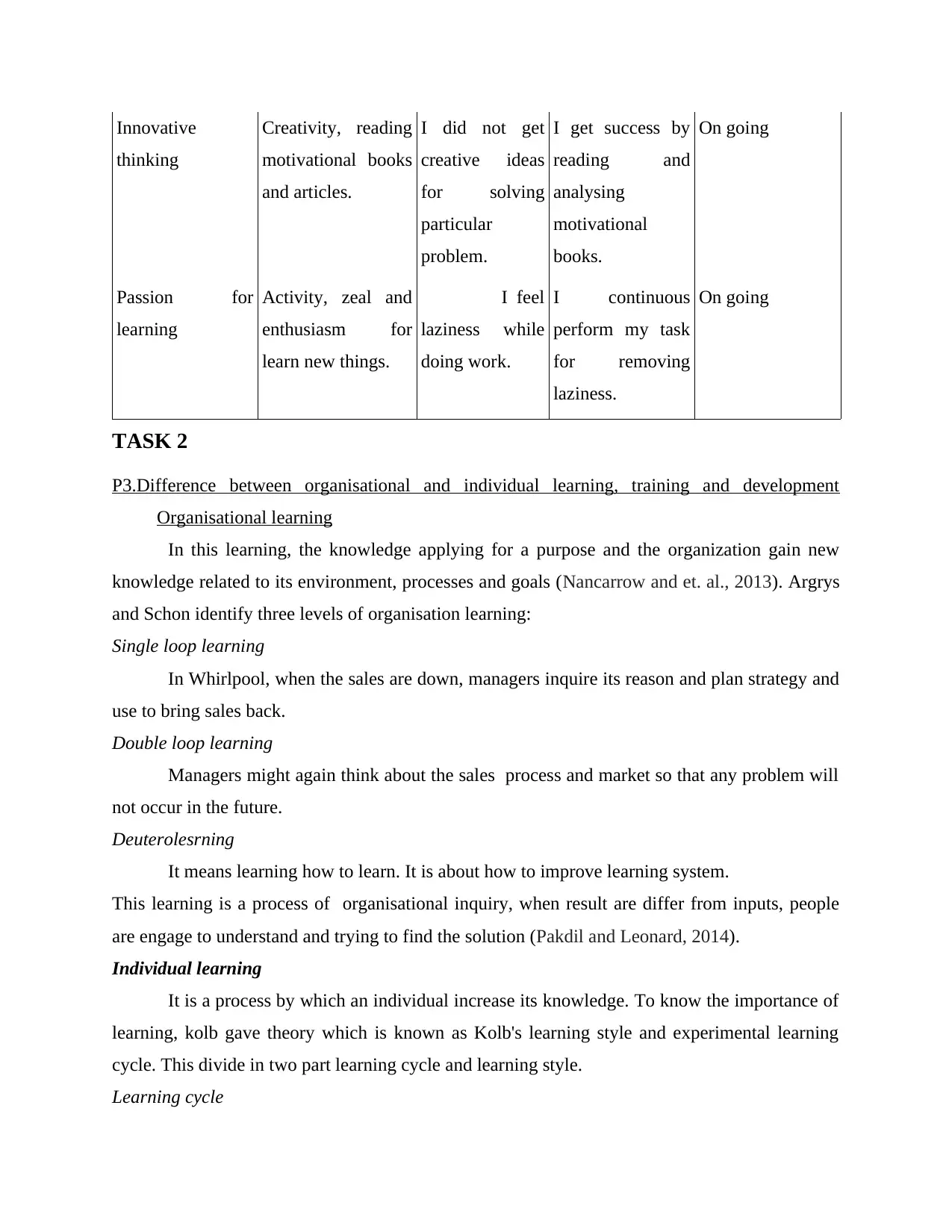
Innovative
thinking
Creativity, reading
motivational books
and articles.
I did not get
creative ideas
for solving
particular
problem.
I get success by
reading and
analysing
motivational
books.
On going
Passion for
learning
Activity, zeal and
enthusiasm for
learn new things.
I feel
laziness while
doing work.
I continuous
perform my task
for removing
laziness.
On going
TASK 2
P3.Difference between organisational and individual learning, training and development
Organisational learning
In this learning, the knowledge applying for a purpose and the organization gain new
knowledge related to its environment, processes and goals (Nancarrow and et. al., 2013). Argrys
and Schon identify three levels of organisation learning:
Single loop learning
In Whirlpool, when the sales are down, managers inquire its reason and plan strategy and
use to bring sales back.
Double loop learning
Managers might again think about the sales process and market so that any problem will
not occur in the future.
Deuterolesrning
It means learning how to learn. It is about how to improve learning system.
This learning is a process of organisational inquiry, when result are differ from inputs, people
are engage to understand and trying to find the solution (Pakdil and Leonard, 2014).
Individual learning
It is a process by which an individual increase its knowledge. To know the importance of
learning, kolb gave theory which is known as Kolb's learning style and experimental learning
cycle. This divide in two part learning cycle and learning style.
Learning cycle
thinking
Creativity, reading
motivational books
and articles.
I did not get
creative ideas
for solving
particular
problem.
I get success by
reading and
analysing
motivational
books.
On going
Passion for
learning
Activity, zeal and
enthusiasm for
learn new things.
I feel
laziness while
doing work.
I continuous
perform my task
for removing
laziness.
On going
TASK 2
P3.Difference between organisational and individual learning, training and development
Organisational learning
In this learning, the knowledge applying for a purpose and the organization gain new
knowledge related to its environment, processes and goals (Nancarrow and et. al., 2013). Argrys
and Schon identify three levels of organisation learning:
Single loop learning
In Whirlpool, when the sales are down, managers inquire its reason and plan strategy and
use to bring sales back.
Double loop learning
Managers might again think about the sales process and market so that any problem will
not occur in the future.
Deuterolesrning
It means learning how to learn. It is about how to improve learning system.
This learning is a process of organisational inquiry, when result are differ from inputs, people
are engage to understand and trying to find the solution (Pakdil and Leonard, 2014).
Individual learning
It is a process by which an individual increase its knowledge. To know the importance of
learning, kolb gave theory which is known as Kolb's learning style and experimental learning
cycle. This divide in two part learning cycle and learning style.
Learning cycle
Paraphrase This Document
Need a fresh take? Get an instant paraphrase of this document with our AI Paraphraser
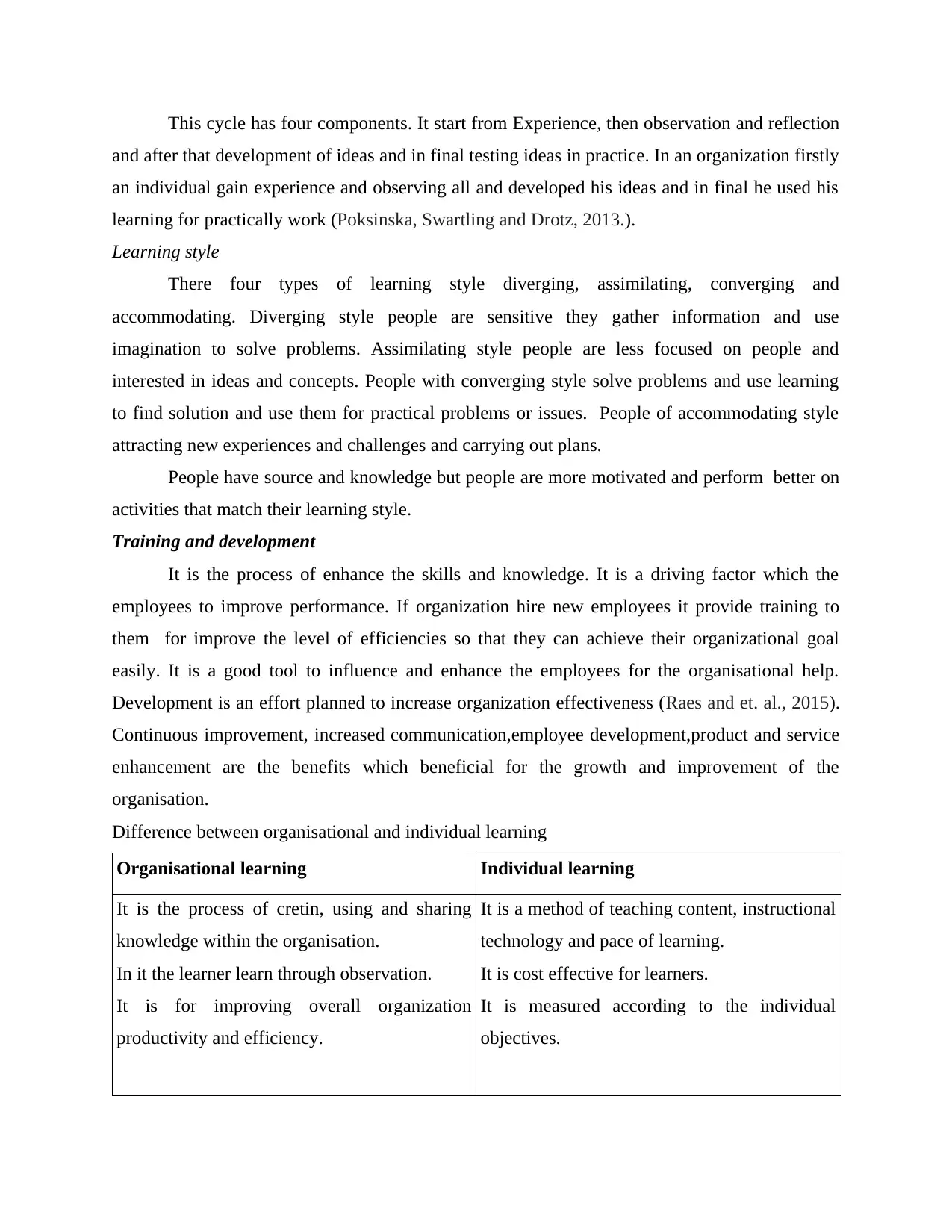
This cycle has four components. It start from Experience, then observation and reflection
and after that development of ideas and in final testing ideas in practice. In an organization firstly
an individual gain experience and observing all and developed his ideas and in final he used his
learning for practically work (Poksinska, Swartling and Drotz, 2013.).
Learning style
There four types of learning style diverging, assimilating, converging and
accommodating. Diverging style people are sensitive they gather information and use
imagination to solve problems. Assimilating style people are less focused on people and
interested in ideas and concepts. People with converging style solve problems and use learning
to find solution and use them for practical problems or issues. People of accommodating style
attracting new experiences and challenges and carrying out plans.
People have source and knowledge but people are more motivated and perform better on
activities that match their learning style.
Training and development
It is the process of enhance the skills and knowledge. It is a driving factor which the
employees to improve performance. If organization hire new employees it provide training to
them for improve the level of efficiencies so that they can achieve their organizational goal
easily. It is a good tool to influence and enhance the employees for the organisational help.
Development is an effort planned to increase organization effectiveness (Raes and et. al., 2015).
Continuous improvement, increased communication,employee development,product and service
enhancement are the benefits which beneficial for the growth and improvement of the
organisation.
Difference between organisational and individual learning
Organisational learning Individual learning
It is the process of cretin, using and sharing
knowledge within the organisation.
In it the learner learn through observation.
It is for improving overall organization
productivity and efficiency.
It is a method of teaching content, instructional
technology and pace of learning.
It is cost effective for learners.
It is measured according to the individual
objectives.
and after that development of ideas and in final testing ideas in practice. In an organization firstly
an individual gain experience and observing all and developed his ideas and in final he used his
learning for practically work (Poksinska, Swartling and Drotz, 2013.).
Learning style
There four types of learning style diverging, assimilating, converging and
accommodating. Diverging style people are sensitive they gather information and use
imagination to solve problems. Assimilating style people are less focused on people and
interested in ideas and concepts. People with converging style solve problems and use learning
to find solution and use them for practical problems or issues. People of accommodating style
attracting new experiences and challenges and carrying out plans.
People have source and knowledge but people are more motivated and perform better on
activities that match their learning style.
Training and development
It is the process of enhance the skills and knowledge. It is a driving factor which the
employees to improve performance. If organization hire new employees it provide training to
them for improve the level of efficiencies so that they can achieve their organizational goal
easily. It is a good tool to influence and enhance the employees for the organisational help.
Development is an effort planned to increase organization effectiveness (Raes and et. al., 2015).
Continuous improvement, increased communication,employee development,product and service
enhancement are the benefits which beneficial for the growth and improvement of the
organisation.
Difference between organisational and individual learning
Organisational learning Individual learning
It is the process of cretin, using and sharing
knowledge within the organisation.
In it the learner learn through observation.
It is for improving overall organization
productivity and efficiency.
It is a method of teaching content, instructional
technology and pace of learning.
It is cost effective for learners.
It is measured according to the individual
objectives.
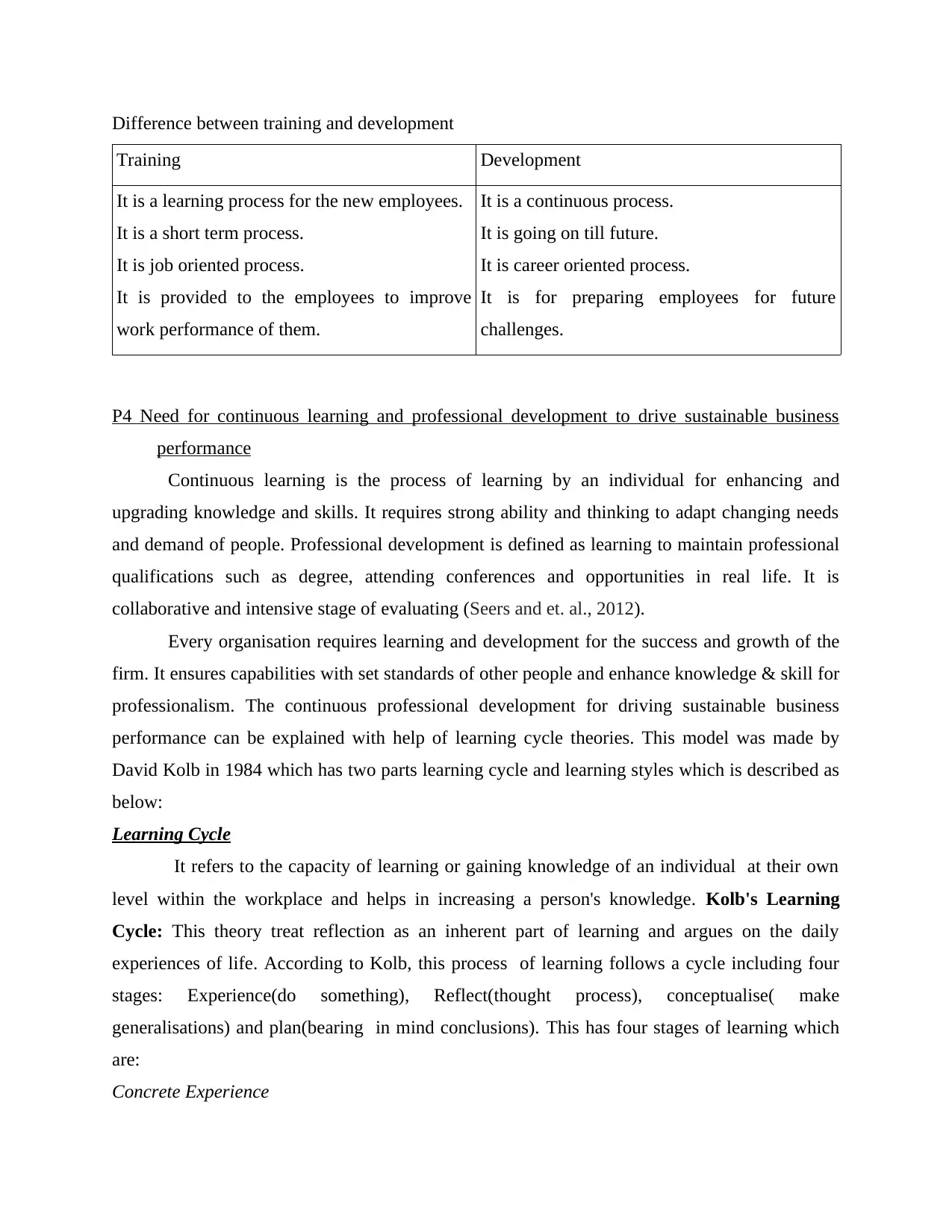
Difference between training and development
Training Development
It is a learning process for the new employees.
It is a short term process.
It is job oriented process.
It is provided to the employees to improve
work performance of them.
It is a continuous process.
It is going on till future.
It is career oriented process.
It is for preparing employees for future
challenges.
P4 Need for continuous learning and professional development to drive sustainable business
performance
Continuous learning is the process of learning by an individual for enhancing and
upgrading knowledge and skills. It requires strong ability and thinking to adapt changing needs
and demand of people. Professional development is defined as learning to maintain professional
qualifications such as degree, attending conferences and opportunities in real life. It is
collaborative and intensive stage of evaluating (Seers and et. al., 2012).
Every organisation requires learning and development for the success and growth of the
firm. It ensures capabilities with set standards of other people and enhance knowledge & skill for
professionalism. The continuous professional development for driving sustainable business
performance can be explained with help of learning cycle theories. This model was made by
David Kolb in 1984 which has two parts learning cycle and learning styles which is described as
below:
Learning Cycle
It refers to the capacity of learning or gaining knowledge of an individual at their own
level within the workplace and helps in increasing a person's knowledge. Kolb's Learning
Cycle: This theory treat reflection as an inherent part of learning and argues on the daily
experiences of life. According to Kolb, this process of learning follows a cycle including four
stages: Experience(do something), Reflect(thought process), conceptualise( make
generalisations) and plan(bearing in mind conclusions). This has four stages of learning which
are:
Concrete Experience
Training Development
It is a learning process for the new employees.
It is a short term process.
It is job oriented process.
It is provided to the employees to improve
work performance of them.
It is a continuous process.
It is going on till future.
It is career oriented process.
It is for preparing employees for future
challenges.
P4 Need for continuous learning and professional development to drive sustainable business
performance
Continuous learning is the process of learning by an individual for enhancing and
upgrading knowledge and skills. It requires strong ability and thinking to adapt changing needs
and demand of people. Professional development is defined as learning to maintain professional
qualifications such as degree, attending conferences and opportunities in real life. It is
collaborative and intensive stage of evaluating (Seers and et. al., 2012).
Every organisation requires learning and development for the success and growth of the
firm. It ensures capabilities with set standards of other people and enhance knowledge & skill for
professionalism. The continuous professional development for driving sustainable business
performance can be explained with help of learning cycle theories. This model was made by
David Kolb in 1984 which has two parts learning cycle and learning styles which is described as
below:
Learning Cycle
It refers to the capacity of learning or gaining knowledge of an individual at their own
level within the workplace and helps in increasing a person's knowledge. Kolb's Learning
Cycle: This theory treat reflection as an inherent part of learning and argues on the daily
experiences of life. According to Kolb, this process of learning follows a cycle including four
stages: Experience(do something), Reflect(thought process), conceptualise( make
generalisations) and plan(bearing in mind conclusions). This has four stages of learning which
are:
Concrete Experience
⊘ This is a preview!⊘
Do you want full access?
Subscribe today to unlock all pages.

Trusted by 1+ million students worldwide
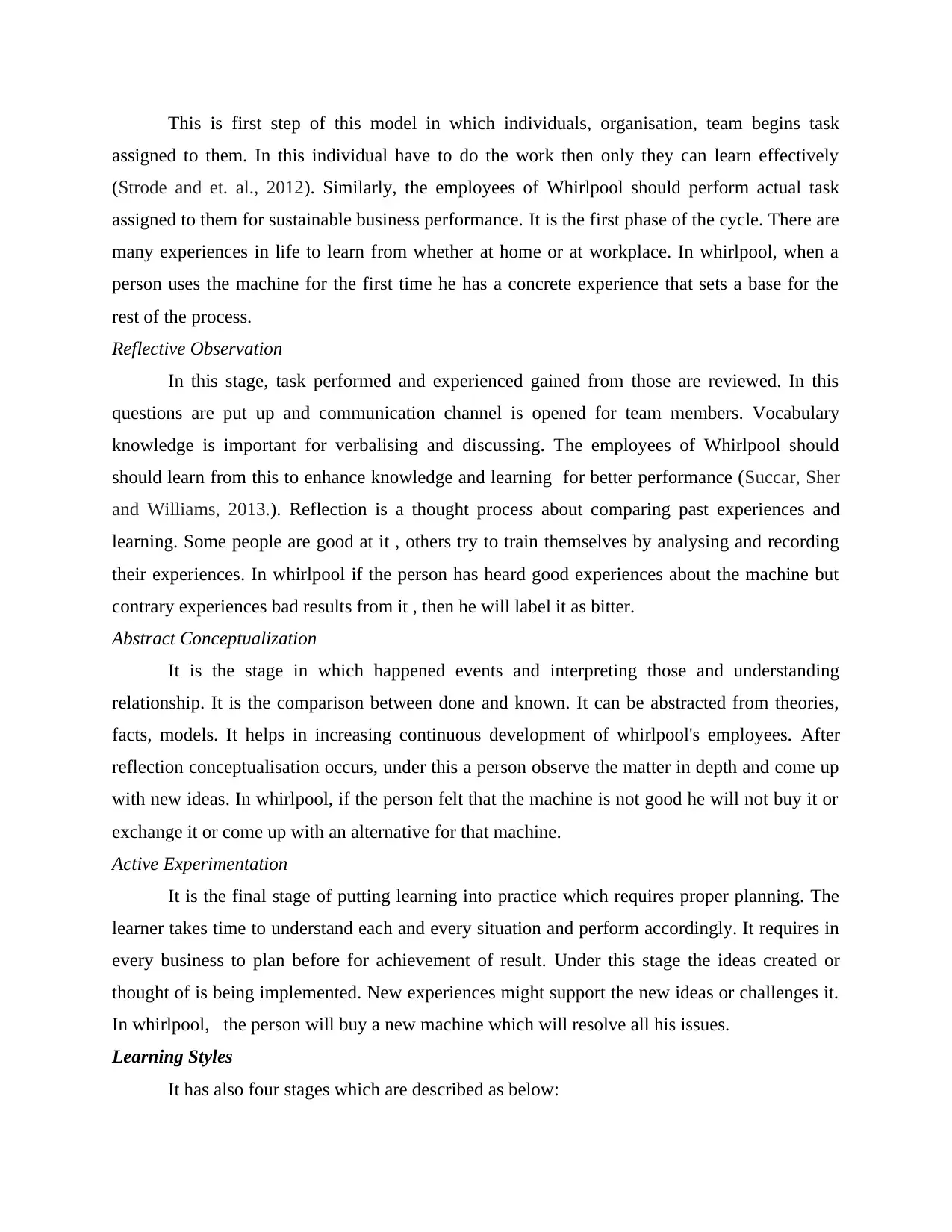
This is first step of this model in which individuals, organisation, team begins task
assigned to them. In this individual have to do the work then only they can learn effectively
(Strode and et. al., 2012). Similarly, the employees of Whirlpool should perform actual task
assigned to them for sustainable business performance. It is the first phase of the cycle. There are
many experiences in life to learn from whether at home or at workplace. In whirlpool, when a
person uses the machine for the first time he has a concrete experience that sets a base for the
rest of the process.
Reflective Observation
In this stage, task performed and experienced gained from those are reviewed. In this
questions are put up and communication channel is opened for team members. Vocabulary
knowledge is important for verbalising and discussing. The employees of Whirlpool should
should learn from this to enhance knowledge and learning for better performance (Succar, Sher
and Williams, 2013.). Reflection is a thought process about comparing past experiences and
learning. Some people are good at it , others try to train themselves by analysing and recording
their experiences. In whirlpool if the person has heard good experiences about the machine but
contrary experiences bad results from it , then he will label it as bitter.
Abstract Conceptualization
It is the stage in which happened events and interpreting those and understanding
relationship. It is the comparison between done and known. It can be abstracted from theories,
facts, models. It helps in increasing continuous development of whirlpool's employees. After
reflection conceptualisation occurs, under this a person observe the matter in depth and come up
with new ideas. In whirlpool, if the person felt that the machine is not good he will not buy it or
exchange it or come up with an alternative for that machine.
Active Experimentation
It is the final stage of putting learning into practice which requires proper planning. The
learner takes time to understand each and every situation and perform accordingly. It requires in
every business to plan before for achievement of result. Under this stage the ideas created or
thought of is being implemented. New experiences might support the new ideas or challenges it.
In whirlpool, the person will buy a new machine which will resolve all his issues.
Learning Styles
It has also four stages which are described as below:
assigned to them. In this individual have to do the work then only they can learn effectively
(Strode and et. al., 2012). Similarly, the employees of Whirlpool should perform actual task
assigned to them for sustainable business performance. It is the first phase of the cycle. There are
many experiences in life to learn from whether at home or at workplace. In whirlpool, when a
person uses the machine for the first time he has a concrete experience that sets a base for the
rest of the process.
Reflective Observation
In this stage, task performed and experienced gained from those are reviewed. In this
questions are put up and communication channel is opened for team members. Vocabulary
knowledge is important for verbalising and discussing. The employees of Whirlpool should
should learn from this to enhance knowledge and learning for better performance (Succar, Sher
and Williams, 2013.). Reflection is a thought process about comparing past experiences and
learning. Some people are good at it , others try to train themselves by analysing and recording
their experiences. In whirlpool if the person has heard good experiences about the machine but
contrary experiences bad results from it , then he will label it as bitter.
Abstract Conceptualization
It is the stage in which happened events and interpreting those and understanding
relationship. It is the comparison between done and known. It can be abstracted from theories,
facts, models. It helps in increasing continuous development of whirlpool's employees. After
reflection conceptualisation occurs, under this a person observe the matter in depth and come up
with new ideas. In whirlpool, if the person felt that the machine is not good he will not buy it or
exchange it or come up with an alternative for that machine.
Active Experimentation
It is the final stage of putting learning into practice which requires proper planning. The
learner takes time to understand each and every situation and perform accordingly. It requires in
every business to plan before for achievement of result. Under this stage the ideas created or
thought of is being implemented. New experiences might support the new ideas or challenges it.
In whirlpool, the person will buy a new machine which will resolve all his issues.
Learning Styles
It has also four stages which are described as below:
Paraphrase This Document
Need a fresh take? Get an instant paraphrase of this document with our AI Paraphraser
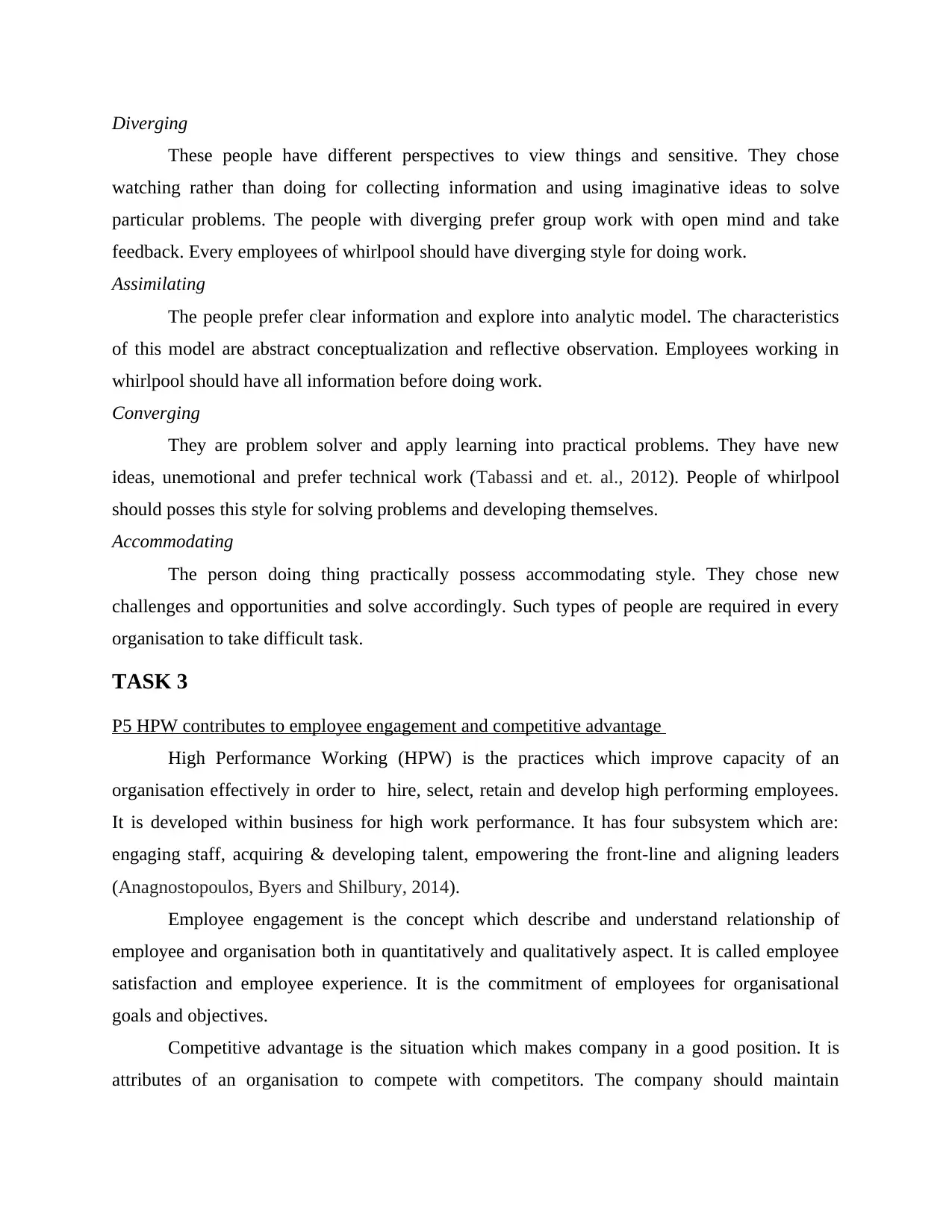
Diverging
These people have different perspectives to view things and sensitive. They chose
watching rather than doing for collecting information and using imaginative ideas to solve
particular problems. The people with diverging prefer group work with open mind and take
feedback. Every employees of whirlpool should have diverging style for doing work.
Assimilating
The people prefer clear information and explore into analytic model. The characteristics
of this model are abstract conceptualization and reflective observation. Employees working in
whirlpool should have all information before doing work.
Converging
They are problem solver and apply learning into practical problems. They have new
ideas, unemotional and prefer technical work (Tabassi and et. al., 2012). People of whirlpool
should posses this style for solving problems and developing themselves.
Accommodating
The person doing thing practically possess accommodating style. They chose new
challenges and opportunities and solve accordingly. Such types of people are required in every
organisation to take difficult task.
TASK 3
P5 HPW contributes to employee engagement and competitive advantage
High Performance Working (HPW) is the practices which improve capacity of an
organisation effectively in order to hire, select, retain and develop high performing employees.
It is developed within business for high work performance. It has four subsystem which are:
engaging staff, acquiring & developing talent, empowering the front-line and aligning leaders
(Anagnostopoulos, Byers and Shilbury, 2014).
Employee engagement is the concept which describe and understand relationship of
employee and organisation both in quantitatively and qualitatively aspect. It is called employee
satisfaction and employee experience. It is the commitment of employees for organisational
goals and objectives.
Competitive advantage is the situation which makes company in a good position. It is
attributes of an organisation to compete with competitors. The company should maintain
These people have different perspectives to view things and sensitive. They chose
watching rather than doing for collecting information and using imaginative ideas to solve
particular problems. The people with diverging prefer group work with open mind and take
feedback. Every employees of whirlpool should have diverging style for doing work.
Assimilating
The people prefer clear information and explore into analytic model. The characteristics
of this model are abstract conceptualization and reflective observation. Employees working in
whirlpool should have all information before doing work.
Converging
They are problem solver and apply learning into practical problems. They have new
ideas, unemotional and prefer technical work (Tabassi and et. al., 2012). People of whirlpool
should posses this style for solving problems and developing themselves.
Accommodating
The person doing thing practically possess accommodating style. They chose new
challenges and opportunities and solve accordingly. Such types of people are required in every
organisation to take difficult task.
TASK 3
P5 HPW contributes to employee engagement and competitive advantage
High Performance Working (HPW) is the practices which improve capacity of an
organisation effectively in order to hire, select, retain and develop high performing employees.
It is developed within business for high work performance. It has four subsystem which are:
engaging staff, acquiring & developing talent, empowering the front-line and aligning leaders
(Anagnostopoulos, Byers and Shilbury, 2014).
Employee engagement is the concept which describe and understand relationship of
employee and organisation both in quantitatively and qualitatively aspect. It is called employee
satisfaction and employee experience. It is the commitment of employees for organisational
goals and objectives.
Competitive advantage is the situation which makes company in a good position. It is
attributes of an organisation to compete with competitors. The company should maintain
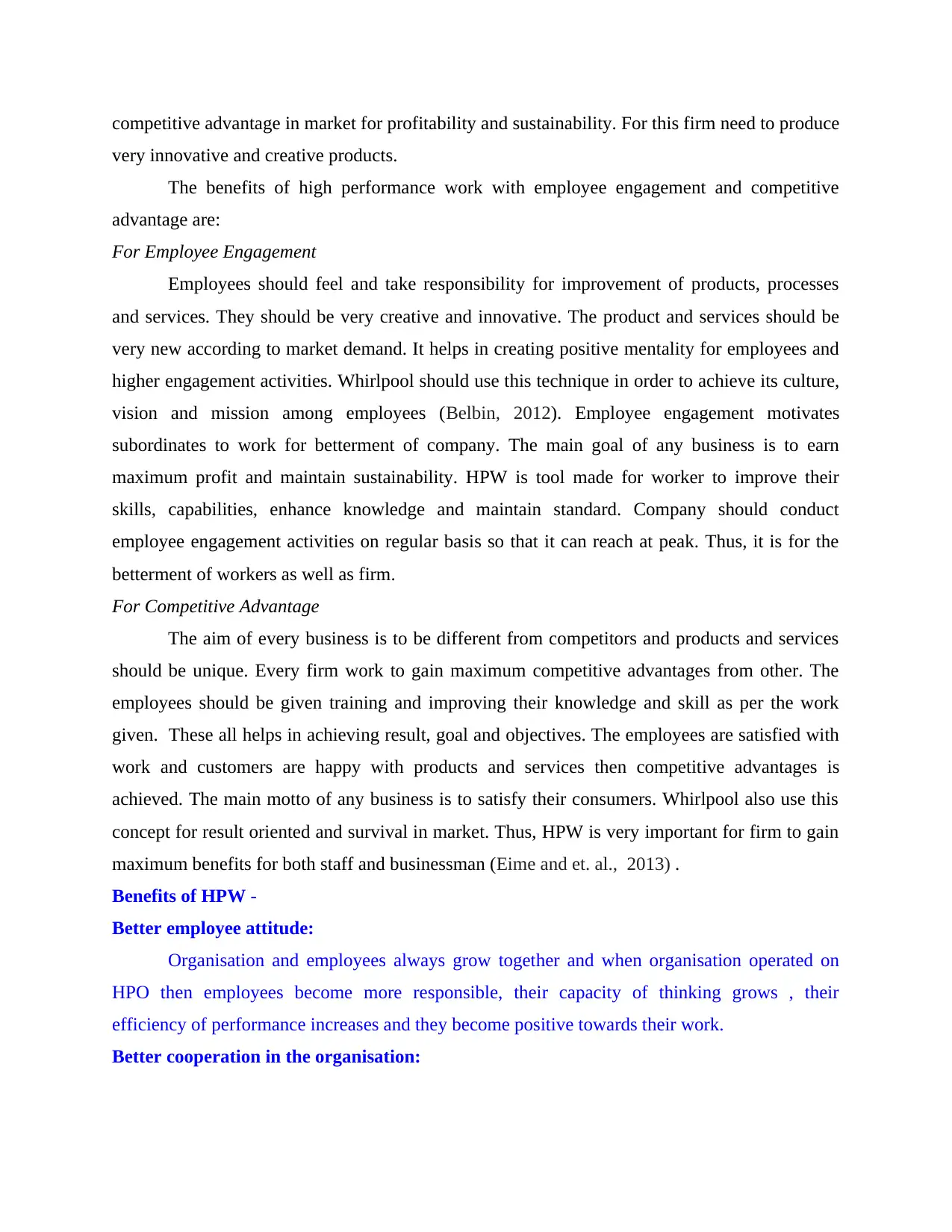
competitive advantage in market for profitability and sustainability. For this firm need to produce
very innovative and creative products.
The benefits of high performance work with employee engagement and competitive
advantage are:
For Employee Engagement
Employees should feel and take responsibility for improvement of products, processes
and services. They should be very creative and innovative. The product and services should be
very new according to market demand. It helps in creating positive mentality for employees and
higher engagement activities. Whirlpool should use this technique in order to achieve its culture,
vision and mission among employees (Belbin, 2012). Employee engagement motivates
subordinates to work for betterment of company. The main goal of any business is to earn
maximum profit and maintain sustainability. HPW is tool made for worker to improve their
skills, capabilities, enhance knowledge and maintain standard. Company should conduct
employee engagement activities on regular basis so that it can reach at peak. Thus, it is for the
betterment of workers as well as firm.
For Competitive Advantage
The aim of every business is to be different from competitors and products and services
should be unique. Every firm work to gain maximum competitive advantages from other. The
employees should be given training and improving their knowledge and skill as per the work
given. These all helps in achieving result, goal and objectives. The employees are satisfied with
work and customers are happy with products and services then competitive advantages is
achieved. The main motto of any business is to satisfy their consumers. Whirlpool also use this
concept for result oriented and survival in market. Thus, HPW is very important for firm to gain
maximum benefits for both staff and businessman (Eime and et. al., 2013) .
Benefits of HPW -
Better employee attitude:
Organisation and employees always grow together and when organisation operated on
HPO then employees become more responsible, their capacity of thinking grows , their
efficiency of performance increases and they become positive towards their work.
Better cooperation in the organisation:
very innovative and creative products.
The benefits of high performance work with employee engagement and competitive
advantage are:
For Employee Engagement
Employees should feel and take responsibility for improvement of products, processes
and services. They should be very creative and innovative. The product and services should be
very new according to market demand. It helps in creating positive mentality for employees and
higher engagement activities. Whirlpool should use this technique in order to achieve its culture,
vision and mission among employees (Belbin, 2012). Employee engagement motivates
subordinates to work for betterment of company. The main goal of any business is to earn
maximum profit and maintain sustainability. HPW is tool made for worker to improve their
skills, capabilities, enhance knowledge and maintain standard. Company should conduct
employee engagement activities on regular basis so that it can reach at peak. Thus, it is for the
betterment of workers as well as firm.
For Competitive Advantage
The aim of every business is to be different from competitors and products and services
should be unique. Every firm work to gain maximum competitive advantages from other. The
employees should be given training and improving their knowledge and skill as per the work
given. These all helps in achieving result, goal and objectives. The employees are satisfied with
work and customers are happy with products and services then competitive advantages is
achieved. The main motto of any business is to satisfy their consumers. Whirlpool also use this
concept for result oriented and survival in market. Thus, HPW is very important for firm to gain
maximum benefits for both staff and businessman (Eime and et. al., 2013) .
Benefits of HPW -
Better employee attitude:
Organisation and employees always grow together and when organisation operated on
HPO then employees become more responsible, their capacity of thinking grows , their
efficiency of performance increases and they become positive towards their work.
Better cooperation in the organisation:
⊘ This is a preview!⊘
Do you want full access?
Subscribe today to unlock all pages.

Trusted by 1+ million students worldwide
1 out of 17
Related Documents
Your All-in-One AI-Powered Toolkit for Academic Success.
+13062052269
info@desklib.com
Available 24*7 on WhatsApp / Email
![[object Object]](/_next/static/media/star-bottom.7253800d.svg)
Unlock your academic potential
Copyright © 2020–2025 A2Z Services. All Rights Reserved. Developed and managed by ZUCOL.




